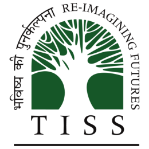
Post-Partition Crisis (1947): Students and Faculty of TISS were engaged as volunteers in refugee camps in Kurukshetra. Their work was appreciated by the then-Prime Minister Pt Jawaharlal Nehru in the following words “We found a difference in the work of TISS volunteers and the work of many others who were earnest and had done their best, but who did not have the training to do it well. There is a difference between the trained workers and the merely enthusiastic workers.”

Bangladesh War (1971): The 1971 Indo-Pak War resulted in the liberation of Bangladesh (then East-Pakistan) as an independent nation. A team of TISS faculty and students worked with those affected in refugee camps, mobilised volunteers, organised relief activities and also provided psychosocial support.

Ahmednagar Drought (1972): A team of students, staff and faculty volunteers from TISS visited ParnerTalukain drought-hit Ahmednagar district during 1972-1973. The team distributed cattle feed and crop micronutrients along with medical supplies. The intervention played a role in addressing post-drought distress migration to cities like Mumbai and Pune.

Bhopal Gas Tragedy (1984): 130 students and 30 faculty members from TISS along with volunteers from other universities were invited by the government Of Madhya Pradesh to conduct a detailed survey of those affected. The team was also involved in the provision of relief support and issuance of identity cards that were instrumental in survivors claiming compensation from the government.

Jambhulpada Floods (1989): TISS (Dept of URCD) had been working on housing and livelihoods issue in Jambhulpada and surrounding villages in Raigad district since 1983. After the devastating floods of 1989 which killed over a hundred people and flattened many villages, TISS responded immediately with rescue and relief support. TISS coordinated with the local administration and NGOs and continued to work for over a decade for long-term recovery and development.

Mumbai Riots (1992): TISS carried out the task of identification of affected families and coordinated the disbursal of compensation in north-eastern Mumbai. Legal aid was provided to the community as TISS worked on liaising between the affected persons and the administration. Later, the team was also involved in providing support for the reconstruction of houses.

Latur Earthquake (1993): The TISS team at rural campus, Tuljapur was among the first to respond due to its proximity to the affected. The team conducted a comprehensive loss assessment survey, coordinated relief activities. and developed an integrated rehabilitation plan with the government. TISS (Dept of URCD) was appointed as community participation facilitator in 52 relocated villages for 5 years within the government’s rehabilitation and recovery programme. This entailed advocacy on several policy matters as also working on conflict resolution and problem solving at the grassroots level. TISS also supported Tata Relief Committee in its total reconstruction of Rajegaon village.

Odisha Supercyclone (1999): The government of Odisha asked for additional volunteers from TISS after a review of its initial work. TISS reorganised its academic schedule and forfeited the vacation period for that academic year in order to participate in the cyclone response.

Gujarat Earthquake (2001): The team of volunteers from TISS worked on co-ordinating relief, organising and managing an information desk with other organisations in Bhuj and examining impacts in various districts. A rapid assessment was carried out at the request of the government, covering 120 villages. Intervention in children’s wards of hospitals such as drawing, crafts and recreational activities along with pyscho-social care to mothers. The team provided feedback and policy support to government departments. It also monitored the social aspects of rehabilitation for Tata Relief Committee in the villages that TRC was working for reconstruction. The engagement (of the Dept of URCD) was for a period of 3 years.

Gujarat Riots (2002): TISS conducted training of trainers with teachers of schools providing them with ways of dealing in the classroom, with the trauma of children who had witnessed riots at close quarters. Faculty members visited relief camps and worked with local groups and government officials who were struggling to gather data, maintain peace, and assuage fear among the minority community. Later with support from Oxfam, a course on Conflict and Peace was introduced for Masters' students specialising in Urban and Rural Community Development. Later this was developed into a concentration in a couple of Masters' programmes.

Tsunami (2004):On 26 December 2004, a massive undersea quake resulted in a tsunami in the Indian Ocean, severely affecting the archipelago of the Andaman and Nicobar Islands which were devastated by deadly waves. More than 3,500 people lost their lives and about 7000 were declared as missing. TISS responded to the disaster in two phases. In the first phase, TISS undertook a rapid needs assessment on all the Nicobar group of islands. Additionally, it provided relief support on remote but large and predominantly tribal island of Katchal. In the second phase, Certificate and Diploma Programmes on sustainable development were introduced for the local youth. Community-based island knowledge centres were set up as a part of which youth groups in each of the southern islands who were then involved as animators in setting up Rural Knowledge Centres in the Nicobars with community ownership.

Mumbai Floods (2005):On 26th July, 2005 the city of Mumbai was left inundated with heavy rainfall. The floods were caused by the eighth heaviest-ever recorded 24-hour rainfall figure of 944 mm (37.17 inches) on 26 July 2005, and intermittently continued for the next day. Of this 644 mm (25.35 inches) was received within the 12-hour period between 8 am and 8 pm. People were stuck at work places, children in schools and many waded through water to get home as traffic came to a grinding halt. Approximately 1,094 people died. The team from TISS was instrumental in early response to the situation. Coordinated relief work was carried out by the team in the M-Ward. Health camps were set up to provide primary health support to those affected. TISS was also responsible for mobilisation and distribution of relief resources while closely networking with the Government of Maharashtra.

26/11 Mumbai Terror Attacks (2008):The terror attack in Mumbai saw TISS faculty respond in four spheres which culminated into a field action project of the School – - The Taj Employees Psychosocial Care and Support - The Immediate Psychosocial Support to Survivors - Long Term Rehabilitation -A research study on hospital preparedness with CEHAT The response to the event eventually led to the initiation of the school’s Field Action Project called – An Avenue for Psychosocial and Therapeutic Interventions or AAPTI

Kosi Floods (2008): JTSDS Students worked in Saharsa for three weeks on damage assessment and NGO coordination with support from the local government. Reports were used for advocacy with the state government and district administration. Students also volunteered in a medical camp. After this, many batches of students of JTSDS, continued to work in the region during their internships and contributed to the recovery phase.

Cyclone Aila (2009): A three-member team comprising two faculty members and one Ph.D scholar visited cyclone Aila affected regions of West Bengal in June 2009. This was followed by advocacy and Tata companies initiated mangrove regeneration with a local organisation. The Schoolreceived reports about poor outreach by the government and that people struggled for resources required for recovery. A detailed study was conducted in 2010 and this resulted in findings and observations around: livelihoods struggle, migration, quantity and quality of relief material distributed by governmental and non-governmental agencies as well as processes of distribution; water, sanitation, hygiene and health and education in formal and informal settlements; and the provision of early warning.

Andhra Floods (2009): A visit to flood affected Mahbubnagar District was carried out by a three member team comprising two faculty members and one Master’s student of Jamsetji Tata Centre for Disaster Management, between 20th and 27th October 2009. The visit was conducted in two phases in order to enable a thorough understanding of the field situation, and to facilitate the planning process for intervention. Unstructured interviews were held with the villagers who were directly or indirectly affected by the flood and the critical observations were shared with district collector.

AMRI Hospital Fire (2011): On the midnight of 9th December 2011, a fire broke out in the Advance Medical Research Unit (AMRI), Dhakuria. As many as 93 lives were lost and 77 were injured in the accident. On request of citizen groups, the TISS extended the AAPTI approach to support the survivors. The response was carried out in 3 phases – In the first phase, rapid needs assessment was carried out by reaching out to the survivors. In the second phase, most vulnerable families were identified and long term support needs were assessed. Lastly, needs of the most marginalised were addressed by facilitating a consortium of governmental and non-governmental support services.

13/7 Mumbai Triple Blasts (2011): In the light of school’s learnings, especially from the response to 26/11 Mumbai Terror Attacks, a pilot study of survivors in hospitals, was initiated immediately after the 13/7 Mumbai blasts. Similar gaps in response and support needs were identified. Hence a decision to extend the services to the survivors of 13/7 Mumbai blast was made and a rapid needs assessment was carried out. To begin with, 119 families were located and immediate needs were identified. The response to the event became a part of the AAPTI field action project of the School.

Uttarakhand Floods (2013):TISS (JTSDS along with School of Social Work) conducted an initial assessment of the worst affected villages among 70 villages in various affected districts of Uttarakhand during July 2013. This report was shared widely with state government, district authorities and civil society organisations.Based on this report, Tata Trusts and other NGOs started their interventions for sustainable development in select the villages. Several students chose this disaster site for their research work and internships.

Cyclone Phailin (2013):Faculty members from the School visited areas affected by Cyclone Phailin in Odisha during the first week of November 2013, and interacted with government officials and affected community to understand the response process andidentified key issues for long-term recovery process. Later, all first year Masters’ students of Disaster Management programme conducted a study visit to the affected places and carried out three weeks of intensive work to understand the impact and the recovery process.

Malin Landslides (2014):In response to this landslide in Ambegaon, Malin, Pune, the faculty members worked with several critical actors including government, non-governmental organizations and affected communities to better understand the context and causes. Over 150 people were buried when the hill slope collapsed after 108mm of rainfall in a 24hour period. Detailed damage assessment, assessment of shelters, documentation of expectation of people from rehabilitation was carried out. The reports were used for advocacy with district administration. Masters’ students of Disaster Management were placed at this site for their three weeks’ fieldwork andthey carried out an ecosystems assessment for recovery planning in the affected area.

Nepal Earthquake (2015): A team of faculty members and student volunteers reached Kathmandu and joined hands with local institutions in providing psychosocial support and temporary shelters. This culminated in a field action project Nepal Earthquake Recovery Support Programme (NERSP) which entailed continued work on community based psychosocial support, construction of transitional shelters demonstrating participatory targeting methodologies for social inclusion, diploma and fellowship in disaster and livelihood recovery, permanent housing recovery support to the most vulnerable, and capacity building of local institutions through joint research, networking, consultancy services and policy advocacy on pertinent issues of bilateral significance.

Kashmir Floods (2014):The School’s faculty were part of the larger team from TISS that responded to the Jammu and Kashmir Floods. They contributed to the preparation of funding proposals, preliminary report, relief distribution and village level rapid initial assessment. The Centre also supported the coordination of volunteers during the relief phase.

M-Ward Fire (2016):Many of the communities in M-Ward in Mumbai are surrounded by godowns, oil tank cleaning services and highways carrying oil tankers, making them prone to fire. Moreover, many houses are built with highly inflammable materials like plastic sheets, tarpaulin, wood etc. In the absence of any effective alternative housing programme, people are forced to stay with this risk. Through ‘Empowering M Ward’ project of TISS, efforts were made for damage assessment, distribution of food, and other relief material along with developing linkages with emergency control room of Municipal Corporation of Greater Mumbai.

Kerala Floods (2018):In response to the Kerala floods in August 2018, faculty members reached out to the state government and to the people of Kerala. The School provided leadership to this initiative and worked with various institutions, more prominently the Kerala State Disaster Management Authority. Two prominent activities emerged. One an invitation from KSDMA to map culverts, gruel centres and PDS stores using GIS in Kuttanad region, which was one of the worst affected.A total of 37 students and 6 faculty members were engaged in this task for two weeks with local support and also that of United Way. Second, was a UNICEF supported partnership that focused on an initiative around accountability to affected populations, which ensured that the voices of the people, especially the marginalized find place in the government’s recovery programme. The work was showcased by government of Kerala at the UN (see: https://www.unicef.org/india/reports/janakiya-pankalithavum-punarnirmanavum-initiative-jpp-i). Faculty members have published an article on the unique methodology that was followed.

Belagavi Floods (2019):Given the continuing field engagement in the areas of disaster response, relief and recovery, two faculty members of JTSDS went to the Belagavi district of Karnataka to carry out a pilot study in flood-affected areas in the region and to arrive at possible interventions to aid recovery in the region. The faculty members spent ten days in the field between 7th October 2019 and 16th October 2019. They engaged with local communities, civil society organizations, local volunteers and functionaries of the local self-governments in order to be better-informed about the post-flood situation.

Kolhapur Floods (2019):The year 2019 recorded the second highest rainfall received by the state of Maharashtra in the last 25 years. About 900 mm rainfall led to the Panchganga, Koyna, Warna and Krishna rivers flowing over the flood level due to which backwaters entered rapidly into the interiors of the villages.The team from TISS comprising faculty members and students carried out hazard, resource, vulnerability mapping for the villages using GIS as well as flood zonation. Additionally, meetings and consultations were held with multiple stakeholders. The School’s students also worked for three weeks in several villages as part of their filed practicum.

Covid-19 Pandemic (2020): The team of volunteers from TISS (JTSDS and School of Habitat Studies) ran a community kitchen which provided about two lakh meals to people in M-Ward. Supplementary nutrition was provided to children for about three months. School’s faculty members also published an article in Scroll on "Pandemic governance in Mumbai" and a policy brief on "vaccine hesitancy" was also presented to NitiAyog. A detailed survey of over 20,000 households with support of ADB was carried out. The institute’s M-Ward project closely worked with state government and NGOs and CBOs on community quarantine centres, health support and online counselling.The team also participated in coordination of awareness activities for vaccine hesitancy, migration of labourers, ration distribution, education etc. A detailed note on recommendations was sent to NDMA with suggestions on interventions with the urban poor. Finding it useful, this note was circulated verbatim by the Additional Secretary to Urban Development Commissioners of all states.

Mumbai Landslides (2021):The team from the School carried out an assessment of vulnerable sites followed by training of communities for community based interventions. Assessment reports from the field were also used for advocacy with administration and state government.

Balasore Train Accident (2023): TISS Field Action Projects iCALL and SIMHA joined with YuvaVikas, Balasore to reach out to the survivors in the immediate aftermath. Consolidating the experiences emerging from this immediate response and that of AAPTI's past work, a detailed proposal for long term recovery support was prepared and circulated to all state governments involved. Bihar State Disaster Management Authority accepted the proposal and provided leadership to the recovery programme in Bihar. JTSDS faculty and students volunteered to support the initiative and also extended the recovery programme to other three states - Odisha, West Bengal and Jharkhand, with funding support from US AID and Give India, as part of the AAPTI project. Students from JTSDS volunteered to: 1. Document the process of disaster response at TISS and the lessons learnt 2. Systematic review of media coverage of the disasters 3. Virtual Needs Assessment and Documenting the Lessons Learnt 4. Systematic Mapping of the Stakeholders Involved in Response to the Balasore Train Disaster.

No news to List












